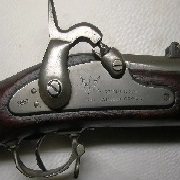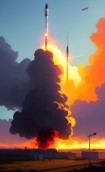|
Sperglord posted:A question I have about the Medium vs. Heavy bomber, were there enough pilots to make the conversion? As in, could you man a much larger Mosquito force if you replaced your heavies with Mosquitos? The mossie was a light bomber.
|
|
|
|

|
| # ? Jun 2, 2024 19:21 |
|
Could the western allies have poured more men and material into close air support and fighter bombers, presumably they were also already doing that anyway?
|
|
|
|
Was there a considerable range advantage for the USAAF heavy bomber fleet and if so, did that allow it to do more than replacement with medium / light bomber focused ones?
|
|
|
|
|
I was watching this footage which is like... half recruitment, half training for the idea of being a P-47 fighterbomber going on a mission to first bomb a bridge, then just hunt down targets to strafe. It starts with tracking down a train by following tracks. Then strafing a lighthouse. Then hitting a radio station, then this moment which had me burst out laughing (linked timestamp): https://www.youtube.com/watch?v=vVDvFOKDZNk&t=1570s
|
|
|
|
That Works posted:Was there a considerable range advantage for the USAAF heavy bomber fleet and if so, did that allow it to do more than replacement with medium / light bomber focused ones? Wikipedia has the range of a B-17 at 2000 mi and the B-25 at 1350 mi so its pretty significant. Medium vs Heavy bomber seems like an odd nomenclature these days because the F-35 can drop 2 tons (typical WWII bomb load) of bombs at 1350 mi on internal payload/fuel. Or at least thats what it says on the tin; I don't think it could do a typical modern strike profile at that range without refueling but it could probably do WWII level bombing from typical cruise altitude.
|
|
|
|
Some flavor of bombing campaign was going to be happening pre-D Day. Itís not like the Allies were just going to sit on their hands and let Germany do what they please in the western front until they had the invasion forces together.
|
|
|
|
Alaan posted:Some flavor of bombing campaign was going to be happening pre-D Day. Itís not like the Allies were just going to sit on their hands and let Germany do what they please in the western front until they had the invasion forces together. And the value of that campaign on targets other than oil plants and transportation infrastructure was questionable.
|
|
|
|
Alaan posted:Some flavor of bombing campaign was going to be happening pre-D Day. Itís not like the Allies were just going to sit on their hands and let Germany do what they please in the western front until they had the invasion forces together. No kidding. That doesn't mean sending thousands of planes to bomb targets roughly the size of "this city, I guess, if I don't get too lost," was the most optimal way to do it. And the proponents of this idea were selling the idea that air power could simply win the war. The RAF tried daytime strategic bombing, decided it was a bad idea, and then the US showed up to say they just didn't have the right planes and proper crews to get it done, the American Way. That might have ruffled some feathers, but the brits weren't going to argue if it meant they could focus on much safer night time bombing while the US simply brute forced their way into eventually outlasting Germany, courtesy of both our industrial/economic might and of the USSR's help.
|
|
|
|
hobbesmaster posted:And the value of that campaign on targets other than oil plants and transportation infrastructure was questionable. It had a huge impact on steel production, and subsequently parts for Luftwaffe fighters and artillery ammunition. Particularly in mid-1943 where the Ruhr bombing raids generated a shortfall of 400,000 tons of steel.
|
|
|
|
Sperglord posted:A question I have about the Medium vs. Heavy bomber, were there enough pilots to make the conversion? As in, could you man a much larger Mosquito force if you replaced your heavies with Mosquitos? This is a good question. None of this is simple 1 for 1 exchanges, but medium bombers usually had crews of 4-6, and light bombers usually had just two or maybe 3. So, you're still having to train a pilot/copilot, bombardier, and navigator for each one (or at least for each couple of planes in a formation) but far fewer gunners. They were also much easier to maintain than the heavies, so there was less need for mechanics. I have no idea how the actual man hours and resources would've broken out, but it is pretty hard to come up with a less efficient way to fight a war than the heavy bombers. That said there would've been some inefficiencies as well, had they taken a different approach. A lighter bomber takes up basically the same amount of tarmac space and requires the same runway facilities, so if you're using twice the number of airframes, you'll need nearly twice the number of ground facilities. That Works posted:Was there a considerable range advantage for the USAAF heavy bomber fleet and if so, did that allow it to do more than replacement with medium / light bomber focused ones? Not in a meaningful way in Europe...all of the mid-war twin engined bombers had a combat radius that could get them to the Polish/Czech border with a normal bombload, and several could go just as far or further than the heavies (the Mosquito was really quite a thing). There were some additional efficiencies built in there as well...the heavies took literally hours to form into their giant formations, whereas lighter bombers in smaller formations could basically take off as one unit and fly straight to the target. Range was a much bigger deal in the Pacific for obvious reasons, but as I stated earlier I think that the use of the heavies there was just as misguided but for other reasons (read: naval mines were incredibly effective).
|
|
|
|
I absolutely understand someone at the time of the 1940s buying into the air power will fix this; just keep bombing (and losing our bombers/people) until it works. It is bonkers to me that in 2019 someone would look back at the US European Theater strategic bombing campaign and say "Ah, what a smashing idea! It worked out great, too!"
|
|
|
mlmp08 posted:I was watching this footage which is like... half recruitment, half training for the idea of being a P-47 fighterbomber going on a mission to first bomb a bridge, then just hunt down targets to strafe. It starts with tracking down a train by following tracks. Then strafing a lighthouse. Then hitting a radio station, then this moment which had me burst out laughing (linked timestamp): "houses around here look kind of suspicious" loving 
|
|
|
|
|
Sperglord posted:A question I have about the Medium vs. Heavy bomber, were there enough pilots to make the conversion? As in, could you man a much larger Mosquito force if you replaced your heavies with Mosquitos? Throatwarbler posted:Could the western allies have poured more men and material into close air support and fighter bombers, presumably they were also already doing that anyway? That Works posted:Was there a considerable range advantage for the USAAF heavy bomber fleet and if so, did that allow it to do more than replacement with medium / light bomber focused ones? The rationale for heavy bombers pre-WW2 wasn't as much about range. Heavy armament was thought to be key to survival (hence the whole Flying Fortress idea), which did not pan out. Bomb loads in turn ended up being more of a linear increase than had been expected - in all ways the heavies were about double a medium, while being less flexible platforms. The Pacific is a different story, though, and late war superheavy bombers really did emphasize extreme range.
|
|
|
|
mlmp08 posted:I was watching this footage which is like... half recruitment, half training for the idea of being a P-47 fighterbomber going on a mission to first bomb a bridge, then just hunt down targets to strafe. It starts with tracking down a train by following tracks. Then strafing a lighthouse. Then hitting a radio station, then this moment which had me burst out laughing (linked timestamp): 8 .50s... Dugga, dugga dugga... thats a lot of lead...
|
|
|
|
hobbesmaster posted:Wikipedia has the range of a B-17 at 2000 mi and the B-25 at 1350 mi so its pretty significant. Nah, the F-35A with a ground attack configuration would have a combat radius of around 650 miles. You gotta get there and back.
|
|
|
|
EvilMerlin posted:Nah, the F-35A with a ground attack configuration would have a combat radius of around 650 miles. Nautical miles and I'm reporting the same stat for the WWII bombers.
|
|
|
|
EvilMerlin posted:You gotta get there and back. Think outside the box
|
|
|
|
hobbesmaster posted:And the value of that campaign on targets other than oil plants and transportation infrastructure was questionable. One thing that complicates the post-war analysis is that Germany was not on a total war footing until after the American daylight effort was underway. For whatever reason, invading Russia wasn't seen as sufficient reason to rationalize their industry and shift to "war stuff only" production. So that "fighter production actually INCREASED during the bombing effort" thing that gets quoted a lot may be misleading. I've never seen a good analysis that separates the effects of moving to a war footing from the destruction caused by the air campaign. Anecdotally, when you read development and operational histories you keep coming across delays due to prototypes being lost to bombing, attacks launching late due to railyard snarls, production stopped after a sub-contractor's factory was destroyed, etc. I'm not saying it was the best use of manpower, engines and aluminum. However, I doubt the cost in Allied lives would have been lower if the resources were put into tactical aircraft and an earlier invasion. The entire human cost of the air campaign was basically Tuesday on the Russian front.
|
|
|
|
I don't have the time or references immediately offhand for an effortpost, but here's some other things that factored in. Without reliable early warning, attackers had the advantage because it was not possible to scramble/intercept fast enough for effective interdiction. Guernica reinforced the burgeoning idea that the bomber always gets through because there was nothing able to effectively stop it. Germany's counter-air effort resulted in tens of thousands of AAA pieces and troops not being used elsewhere. This included a few hundred (or maybe a few thousand, will check and edit later) 88 cannons. For comparison, at the time of the Normandy landings there were only dozens of 88s that were available to Rommel. It was a sufficient diversion of resources that would have been useful on either front. German production did go up, but that was because German industry wasn't working 24/7 until late in the war. Part of the nazi propaganda machine was to preserve the illusion that all was well for as long as possible, and a fully mobilized economy would shatter that illusion. Goering also said something to the extent of 'If a single enemy bomber reaches the Ruhr, you can call me Meier', so the bombing campaign did have a hand in keeping nazism dead by undermining faith in leadership and reminding citizens that they were defeated in a way they didn't feel in the aftermath of WWI. With the benefit of modern doctrine it's there's no doubt allied air forces could have been used more intelligently to achieve greater effect with reduced losses, but the decision makers involved at the time grew up doing stuff with horses. This is not an endorsement of terror bombing. e. thinking out loud, but I wonder if the capital destruction caused by the war would have been significantly less without the bombing campaign, and if so, how much it America's post-war economy benefited from it. Guest2553 fucked around with this message at 19:01 on Jan 2, 2019 |
|
|
|
Fortunately, if one doesn't want to accept that America hosed up with its bombing campaign in Europe, they can just look at how much blood, steel, oil, etc, Germany expended in the air campaign portion of the Battle of Britain and laugh. Chain Home MVP.
|
|
|
|
Mortabis posted:It had a huge impact on steel production, and subsequently parts for Luftwaffe fighters and artillery ammunition. Particularly in mid-1943 where the Ruhr bombing raids generated a shortfall of 400,000 tons of steel. It's less "should the Allies have bombed" and more "how should the Allies have bombed," under which there are two specific considerations. The first is target selection. The attacks on industrial targets clearly had a useful effect, though not as great a one as air power proponents during the war suggested. The diversion of resources and men to air defense was also a major benefit. What was not militarily effective was de-housing/firebombing/generalized city-smashing raids. Those killed a lot of people, but didn't really do anything to impede the German military in and of themselves, and not going after industrial targets actually reduced the effect for resources expended. Obviously some industrial targets were embedded in cities and the technology of the day meant you were going to blow up a lot of houses trying to hit a railyard, but even purely on a cold cost/benefit analysis the Allies should have done that as opposed to targeting residential areas on purpose. There's a legitimate argument that the resources spent on bombing Japan would have been better spent elsewhere, which bewbies covered well, which doesn't hold for the ETO. But even if that's set aside, the data for target selection points to the same conclusions there - de-housing and firebombing raids aren't militarily justifiable. The same and probably more benefit could have been realized by focusing on military and industrial targets instead of making the rubble bounce. This leads into the second consideration - aircraft selection. In the ETO, the one thing heavies were legitimately better at was city smashing... except as mentioned that wasn't actually a good approach. With that in mind, using the same number (or perhaps even fewer) of medium bombers would have reaped the same rewards for less risk and expenditure, in resources and lives. In addition the medium bombers would have been more generally useful. The medium vs heavy debate probably comes down more in favor of heavies in the PTO, just due to the distances involved, even with pre/early war designs not really being optimized for range. It's also important to remember that the data for these arguments existed during the war - it's not all hindsight. In fact most of the "hindsight" is simply resurfacing old reports and debates that had been suppressed or obscured post-war for political reasons or due to the changes brought about by nuclear weapons.
|
|
|
|
Comrade Gorbash posted:It's also important to remember that the data for these arguments existed during the war - it's not all hindsight. In fact most of the "hindsight" is simply resurfacing old reports and debates that had been suppressed or obscured post-war for political reasons or due to the changes brought about by nuclear weapons. And we won the war so it must've worked even if it wasn't optimal. Therefore we can directly apply this to Vietnam!
|
|
|
|
And also Korea!
|
|
|
|
Raenir Salazar posted:It's a huge number of shells, gun tubes, rubber, tools, nitrates, chemicals etc that could have gone into more tanks maybe. from what I recall something close to a fourth of all total german war production was concentrated on shooting down planes.
|
|
|
|
Party Plane Jones posted:from what I recall something close to a fourth of all total german war production was concentrated on shooting down planes. How much of Allied war production was concentrated on making planes
|
|
|
|
hobbesmaster posted:And we won the war so it must've worked even if it wasn't optimal. This is kind of the basis for my whining about the whole thing. The technowar side of conflict seems to be increasingly important, if not dominant, in the information age. Effectively assessing the results of your efforts is the centerpiece of that. The strategic bombing campaign was one of the first examples of what we'd now call "technowar" and as such, is a really good example of how otherwise competent military leaders might behave in the context of fog of war and all that. Those guys had all of the information necessary to make smarter decisions, but they didn't. That they didn't, and why they didn't, is very important. The fact that a lot of the same guys did a lot of the same things in subsequent wars sort of underpins the whole problem set.
|
|
|
|
https://twitter.com/DavidMDrucker/status/1080542918593728512 I realize the comment is modern politics but ignoring that part of the moment; what was the Soviet official line about Afghanistan back in the 80s and what did they say when they pulled out?
|
|
|
|
bewbies posted:This is kind of the basis for my whining about the whole thing. Thats why that McNamara documentary is interesting; he and everyone else at the pentagon thought that they could win Vietnam like they won Japan if they just got the numbers right.
|
|
|
|
hobbesmaster posted:Thats why that McNamara documentary is interesting; he and everyone else at the pentagon thought that they could win Vietnam like they won Japan if they just got the numbers right. Despite, well, Japanese leaders and Vietnamese leaders/fighters having goals so different that it's insane to compare the two.
|
|
|
|
hobbesmaster posted:https://twitter.com/DavidMDrucker/status/1080542918593728512 There's some truth in this but it's the end point of a lot of complicated internal Afghan politics throughout the 70s, and the fact that the USSR wasn't entirely sure what it wanted out of its relationship with Afghanistan before finally settling on "satellite state" after getting frustrated with dealing with various political leaders there. The line when they pulled out was basically the same one the US used when they pulled out of Vietnam and now with Iraq and Afghanistan - it was time to turn things over to local forces, and that continued engagement wasn't worth the costs.
|
|
|
|
mlmp08 posted:Despite, well, Japanese leaders and Vietnamese leaders/fighters having goals so different that it's insane to compare the two. It's not even that. Japan was fighting a war that required industrialization: 1000's of aircraft, 10's of thousands of motor vehicles, hundreds of thousands of soldiers, millions of tons of shipping all spread across a significant portion of the globe. The Vietnamese were fighting in their own country and didn't need much material support above what some very light industry can support. And so you get images of B-52's smearing acres of rice paddies where arguably the bomb was worth far more than the crater could ever amount to.
|
|
|
|
aphid_licker posted:How much of Allied war production was concentrated on making planes the us aerospace industry jumped from #41 in terms of % of gdp to #1 so a lot, apparently
|
|
|
|
mlmp08 posted:Think outside the box You have vtol marine f35s refueling other marine or navy f35 while the airforce f35 have to use their own differant f35s for refueling because for some reason they have to use a differance refueling tech.
|
|
|
|
wargames posted:You have vtol marine f35s refueling other marine or navy f35 while the airforce f35 have to use their own differant f35s for refueling because for some reason they have to use a differance refueling tech. Huh? The plane that mostly does refueling for the US is the KC-135 (going away soon) & KC-10 (eventually KC-46) can refuel both boom and hose-n-droge via MPRSs and WARPs. Why does the USAF use boom and the USN and USMC use hose-n-drogue? Because USAF aircraft typically need more fuel as they are flying longer distances (not carrier based...) and need it to get it faster. And hose-n-drogue take up a lot less space which is of a serious premium on a carrier. EvilMerlin fucked around with this message at 21:28 on Jan 2, 2019 |
|
|
|
wargames posted:You have vtol marine f35s refueling other marine or navy f35 while the airforce f35 have to use their own differant f35s for refueling because for some reason they have to use a differance refueling tech. Doolittle raid
|
|
|
|
EvilMerlin posted:Huh? Hes saying the F-35B and F-35C can buddy tank but F-35A can't. I think.
|
|
|
|
hobbesmaster posted:Hes saying the F-35B and F-35C can buddy tank but F-35A can't. Yeah thats why I was asking for clarification... I was confused...
|
|
|
|
Oh and KC-135s aren't going anywhere anytime soon: https://www.airforce-technology.com/uncategorised/newsusaf-receives-block-45-upgrade-45th-first-kc-135-5724741/ Better article: https://www.aviationtoday.com/2017/08/28/rockwell-collins-usaf-upgrades-kc-135s-flying-90s/ quote:During the next 12 months, the wing plans to have five of its KC-135s upgraded. According to Streck, this should allow them to fly until 2040 or 2050. If the aircraft stay operational for that amount of time, they will have been in service for some nine decades. hobbesmaster fucked around with this message at 21:32 on Jan 2, 2019 |
|
|
|
Hauldren Collider posted:Doolittle raid
|
|
|
|

|
| # ? Jun 2, 2024 19:21 |
|
wargames posted:You have vtol marine f35s refueling other marine or navy f35 while the airforce f35 have to use their own differant f35s for refueling because for some reason they have to use a differance refueling tech. The Air Force uses boom refueling because it's better for bombers/transports, since it can pump fuel faster, and is easier for pilots since the boom operator handles the connection process. The Navy/USMC and most ROW air forces use probe and drogue because it's simpler and cheaper, and multiple aircraft can refuel at once which offsets the lower fuel flow rates. (also the pilots have to catch the drogue on a spike while it's bouncing around behind the tanker) 
|
|
|




















